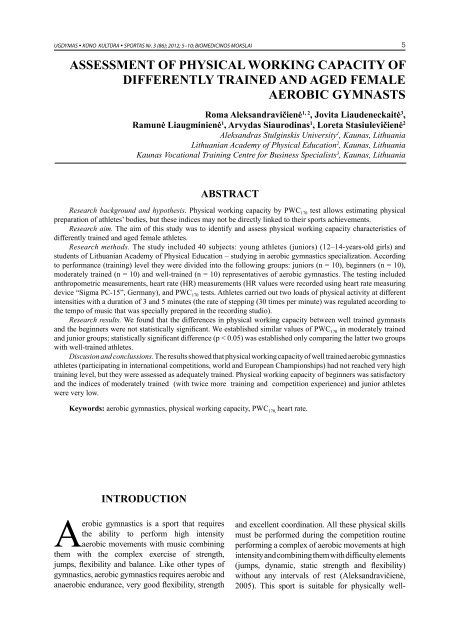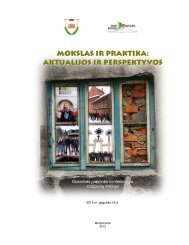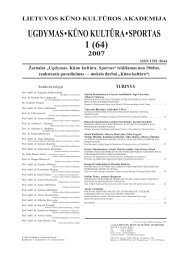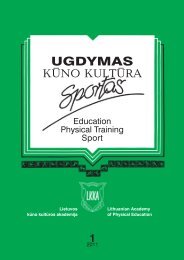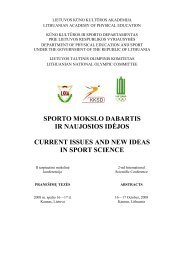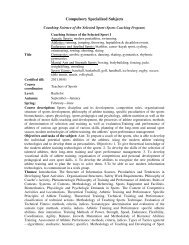UGDYMAS KÛNO KULTÛRA - Lietuvos kūno kultūros akademija
UGDYMAS KÛNO KULTÛRA - Lietuvos kūno kultūros akademija
UGDYMAS KÛNO KULTÛRA - Lietuvos kūno kultūros akademija
You also want an ePaper? Increase the reach of your titles
YUMPU automatically turns print PDFs into web optimized ePapers that Google loves.
<strong>UGDYMAS</strong> � KŪNO KULTŪRA � SPORTAS Nr. 3 (86); 2012; 5–10; BIOMEDICINOS MOKSLAI<br />
ASSESSMENT OF PHYSICAL WORKING CAPACITY OF<br />
DIFFERENTLY TRAINED AND AGED FEMALE<br />
AEROBIC GYMNASTS<br />
Roma Aleksandravičienė 1, 2 , Jovita Liaudeneckaitė 3 ,<br />
Ramunė Liaugminienė 1 , Arvydas Siaurodinas 1 , Loreta Stasiulevičienė 2<br />
Aleksandras Stulginskis University 1 , Kaunas, Lithuania<br />
Lithuanian Academy of Physical Education 2 , Kaunas, Lithuania<br />
Kaunas Vocational Training Centre for Business Specialists 3 , Kaunas, Lithuania<br />
ABSTRACT<br />
Research background and hypothesis. Physical working capacity by PWC 170 test allows estimating physical<br />
preparation of athletes’ bodies, but these indices may not be directly linked to their sports achievements.<br />
Research aim. The aim of this study was to identify and assess physical working capacity characteristics of<br />
differently trained and aged female athletes.<br />
Research methods. The study included 40 subjects: young athletes (juniors) (12–14-years-old girls) and<br />
students of Lithuanian Academy of Physical Education – studying in aerobic gymnastics specialization. According<br />
to performance (training) level they were divided into the following groups: juniors (n = 10), beginners (n = 10),<br />
moderately trained (n = 10) and well-trained (n = 10) representatives of aerobic gymnastics. The testing included<br />
anthropometric measurements, heart rate (HR) measurements (HR values were recorded using heart rate measuring<br />
device “Sigma PC-15”, Germany), and PWC 170 tests. Athletes carried out two loads of physical activity at different<br />
intensities with a duration of 3 and 5 minutes (the rate of stepping (30 times per minute) was regulated according to<br />
the tempo of music that was specially prepared in the recording studio).<br />
Research results. We found that the differences in physical working capacity between well trained gymnasts<br />
and the beginners were not statistically significant. We established similar values of PWC 170 in moderately trained<br />
and junior groups; statistically significant difference (p < 0.05) was established only comparing the latter two groups<br />
with well-trained athletes.<br />
Discusion and conclussions. The results showed that physical working capacity of well trained aerobic gymnastics<br />
athletes (participating in international competitions, world and European Championships) had not reached very high<br />
training level, but they were assessed as adequately trained. Physical working capacity of beginners was satisfactory<br />
and the indices of moderately trained (with twice more training and competition experience) and junior athletes<br />
were very low.<br />
Keywords: aerobic gymnastics, physical working capacity, PWC 170, heart rate.<br />
INTRODUCTION<br />
Aerobic gymnastics is a sport that requires<br />
the ability to perform high intensity<br />
aerobic movements with music combining<br />
them with the complex exercise of strength,<br />
jumps, flexibility and balance. Like other types of<br />
gymnastics, aerobic gymnastics requires aerobic and<br />
anaerobic endurance, very good flexibility, strength<br />
and excellent coordination. All these physical skills<br />
must be performed during the competition routine<br />
performing a complex of aerobic movements at high<br />
intensity and combining them with difficulty elements<br />
(jumps, dynamic, static strength and flexibility)<br />
without any intervals of rest (Aleksandravičienė,<br />
2005). This sport is suitable for physically well-<br />
5


